
Flames leapt into the June sky, illuminating the attentive faces of the surroundng watchers, while waves of heat rolled off the fire. Around us was darkness, mountains, and forest.
I was thirsty, so I walked over the cooler to get some water. On the way back, my boot felt loose, so I put it up on the front pumper of Engine 968 to re-lace it.
“It’s a great bonfire,” I thought. “Too bad it’s ten days early.” This was the night of June 11, 2022, and the solstice will come at 3:14 a.m. local (Mountain) time on the 21st.
I live in a Colorado county where evangelical Protestanism is the dominant faith, although there are others, and all the local political races are settled in the Republican primary.((As an unaffiliated voter, I can vote in either major party’s primary, so this year I voted as an imaginary Republican, since the alternative is to have no candidates at all.)) But since I was here, I tried a Wiccan reading of the event: The fire was lit, and people assembled. (That perhaps is backwards from normal practice.) We cast the circle — not drawing it with a sword but digging it with pulaskis, MacLeods, and combi tools.

Then we marked it in fire —two people circled the perimeter with drip torches to make sure eveyrhing burned
And in water. Another celebrant drove deosil around the circle in a Type 4 wildland engine, spraying a “wet line.”
No salt though.
Pagan-studies scholar Helen Berger recently wrote a summer solstice-themed article for The Conversation (“Academic rigor, journalistic flair”) titled “Wiccan celebration of summer solstice is a reminder that change, as expressed in nature, is inevitable.”
All sabbats begin by creating sacred space, mostly outdoors when the weather permits. This is done by those leading the ritual walking around an area, chanting as a form of prayer and sprinkling the area with water and salt, which are believed to be spiritually cleansing.
And it occurs to me that a hypothecal Smokey Bear coven could do a heckuva circle-casting just with what is carried on the trucks. How about a ring of Class A foam?
After all, Smokey Bear is a face of the Great Bear, one of the oldest religions of all. The somewhat Pagan-ish American Buddhist philosopher and poet Gary Snyder composed a sutra for Smokey [the] Bear in 1969. Here it is with some commentary that he wrote in 2005, published in the Buddhist magazine Tricycle.
In the sutra, I see Smokey as the incarnation of the ancient brown bear of the North and of [the Japanese mountain bodhisattva] Fudo at the same time. But, of course, the Forest Service didn’t know anything about all those associations and reverberations. That was part of the fun of it all, turning the establishment’s imagery on its head.
You read this far and you are still wondering about the fire? The larger fire department in my county and the smaller one to which I belong are operating under a temporary “automatic mutual aid” plan for wildfires because it is so dry now. If a fire pops up in their service area or ours, the other department is dispatched too.
This was in their area: it took our two engines an hour just to drive there.
In this case, a member of one of the well-established ranching families, stewards of the land, etc etc., had piled up an acre of “slash” — stumps, tree trunks, limbs and so onefrom logging or fire mitigation (ironic) or whatever. All nicely dry.
, and they sure lit up local Facebook pages as well. It was like a small lumberyard on fire — there was no way we had enough water to put it out, so we just made it burn more completely. One lucky engine crew (not mine) got to stay all night to monitor it.

 I was checking someone on the University of North Texas website today while working on a future Pomegranate article
I was checking someone on the University of North Texas website today while working on a future Pomegranate article 




 As ever, book reviews in The Pomegranate: The International Journal of Pagan Studies are open-access free downloads. Here are links to the four in this issue.((I receive a small commission on Amazon sales, which helps to pay for this website.))
As ever, book reviews in The Pomegranate: The International Journal of Pagan Studies are open-access free downloads. Here are links to the four in this issue.((I receive a small commission on Amazon sales, which helps to pay for this website.))

 The Imagination of Plants: A Book of Botanical Mythology
The Imagination of Plants: A Book of Botanical Mythology
